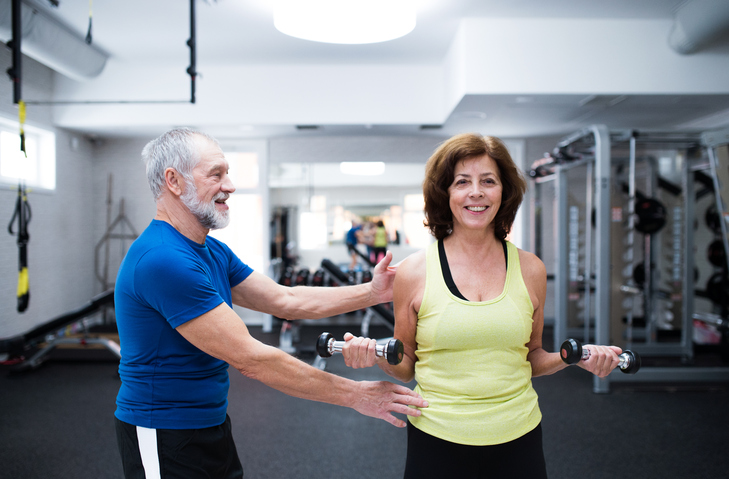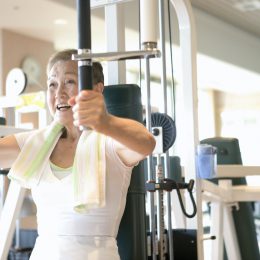Guía para principiantes al gimnasio
Ingresar a un club por primera vez puede ser un choque cultural. Here's how to get over it-and get the most out of your membership.

I've seen the look a hundred times. An older adult, standing in the middle of the gym, looks down at the piece of paper on their clipboard. Then they look up. Seeing nothing that connects the instructions they've been given and the array of machines and weights and benches surrounding them, their face starts to sag.
How is it, they wonder, that all the people around them know exactly what to do, but they don't? Are they privy to some secret set of instructions?
No, of course not. But they did probably benefit from early exposure. Middle schools now have fully equipped weight rooms, and if a kid plays sports today, there's a chance their team will work with a professional strength coach at some point.
The boomer generation, on the other hand, could easily go five or six decades without anyone suggesting you learn 27 different ways to use a dumbbell, or how to adjust the seat on a leg curl machine.
But don't worry. It's not that complicated. Here's a beginner's guide to help you navigate the gym.
Get and stay active with SilverSneakers! Classes and events are happening daily at participating gyms, online through SilverSneakers LIVE, and at community centers near you. Activate your free online account to get started.
Step 1: Get a Tour
I joined my first commercial gym in 1980. Despite the fact I'd worked out with weights for 10 years by that point, and had access to weight machines in both high school and college, I was still bewildered by some of the equipment. I can only imagine how confusing it would be to someone who not only hasn't used any of the weights or machines, but isn't even sure why she should.
This first step, then, is the biggest and most important. Have someone walk you through the gym and show you where everything is. Don't expect to understand immediately what it all does, much less how to use it. You're just establishing a baseline frame of reference so it looks a bit more familiar the next time you see it.
Even more important, you'll get a sense of what other people are doing, and where they're doing it. This truly matters for your safety. Think of a gym like a crosswalk on a busy street. If you wait for the light and look both ways, it's perfectly safe. But if you don't look, things can get ugly.
Step 2: Request a Training Program
Unless you have some workout experience and a high degree of confidence in your knowledge, you'll get the best results from a program created for you by a trainer. Make sure it's printed so you know exactly what you're supposed to do, and that the sheet has room to record what you actually do-how much weight you use and how many times you lift it.
Another option: Get workout programs you can tailor to your fitness level and track your progress with SilverSneakers GO (free, iOS and Android).
Step 3: Know How to Do Each Exercise in Your Program
This is really two pieces of knowledge: where the equipment is and how to use it. Remember the comparison of the gym to a crosswalk? You don't want to wander into the path of someone lifting heavy weights. Like a driver who has a green light, that lifter doesn't expect someone to walk into his space without looking.
Likewise, you could hurt yourself if you do an exercise wrong. And even if you don't, you may not get the intended benefits.
Step 4: Learn How to Adjust Every Machine in Your Program
Even if you know the purpose of an exercise machine and have a solid idea of what you're supposed to do with your arms or legs or torso, you still might not know how to adjust the machine to fit your proportions. This is especially true if the trainer who set up your program did all the adjustments as they took you through it.
Believe me, I can relate. I rarely use machines, but when I do, I have to fumble around for a few minutes until I figure out which pin or lever makes which adjustment. Sometimes I give up and ask a trainer, despite the fact I've worked out in commercial health clubs for 37 years.
Don't feel bad if it isn't immediately apparent to you. And don't be shy about asking for help.
Recommended reading: Free Weights Versus Strength Machines: Which Is Best?
Step 5: Make Sure You Know How Much Weight or Resistance to Use
If the trainer who wrote your program did his job, he should’ve made an educated guess at the appropriate weight for each exercise, or an appropriate level of resistance for the exercises that involve resistance bands. Keep in mind, however, that these are just the starting weights—they will change as you progress.
Step 6: Understand How to Gauge Your Progress
The goal of strength training is to get stronger. If you’ve never done any of these exercises before or never done them within a structured program, your strength will increase pretty fast. That’s great. It’s exactly what’s supposed to happen.
But a lot of seniors keep using the same weights long after they stop being a challenge. At that point, you’re just going through the motions. That’s still better than not going through the motions, but it’s not giving you the benefits you want.
Suscríbase a nuestro boletín informativo
Es rápido y fácil: Usted podría estar entre las 13 millones de personas elegibles.
¿Ya es miembro? Haga clic para descubrir nuestros más de 15,000 centros participantes.
Síganos
Step 7: Plan What Comes Next
A good program doesn't have an expiration date, but you will hit a point of diminishing returns. It could be in 12 weeks if you're an absolute beginner, or just three to four weeks if you're pretty fit. Whenever it happens, you need to change things up, with new (and hopefully more challenging) exercises and techniques. If you're not sure how to tweak your workout, ask a trainer to do it for you-or give you a new program.
Your goal is to keep making progress. Along with strength and overall fitness, you’ll improve your balance and coordination. You’ll feel the difference with every step you take. You’ll walk faster and get up and down stairs more easily. You’ll lift and carry boxes and bags and the occasional grandchild like you could 20 years ago. (Learn more about functional fitness here.)
Even more important, you gain confidence in your ability to do something that was entirely new and strange to you just a few short weeks or months ago.
That confidence is what makes the next step so satisfying.
Step 8: Help Someone Out
At some point in the near future, if you keep up with your program and get comfortable in the gym environment, you’ll see someone just like the person I described at the beginning.
Your first thought will probably be, “What’s their problem?”
But it's your second thought that really matters, when you recognize that look of profound bewilderment and remember that was you not so very long ago. You'll politely ask if they could use some help, and when they gratefully accept, you'll realize that joining a gym was one of the best decisions you ever made.
Verifique su elegibilidad para SilverSneakers al instante
SilverSneakers members can go to thousands of nationwide gyms and fitness locations, plus take SilverSneakers LIVE online classes that are designed for all fitness levels and abilities. If you have a Medicare Advantage plan, it may include SilverSneakers — at no additional cost. Verifique su elegibilidad al instante aquí.
Already a member? Get your SilverSneakers member ID and exclusive fitness and wellness content by activating your online account here.
¿No es elegible para SilverSneakers? todavía puede obtener gratis más de 200 videos de SilverSneakers On-Demand y mantenerse en contacto con nosotros, creando su cuenta en línea.





